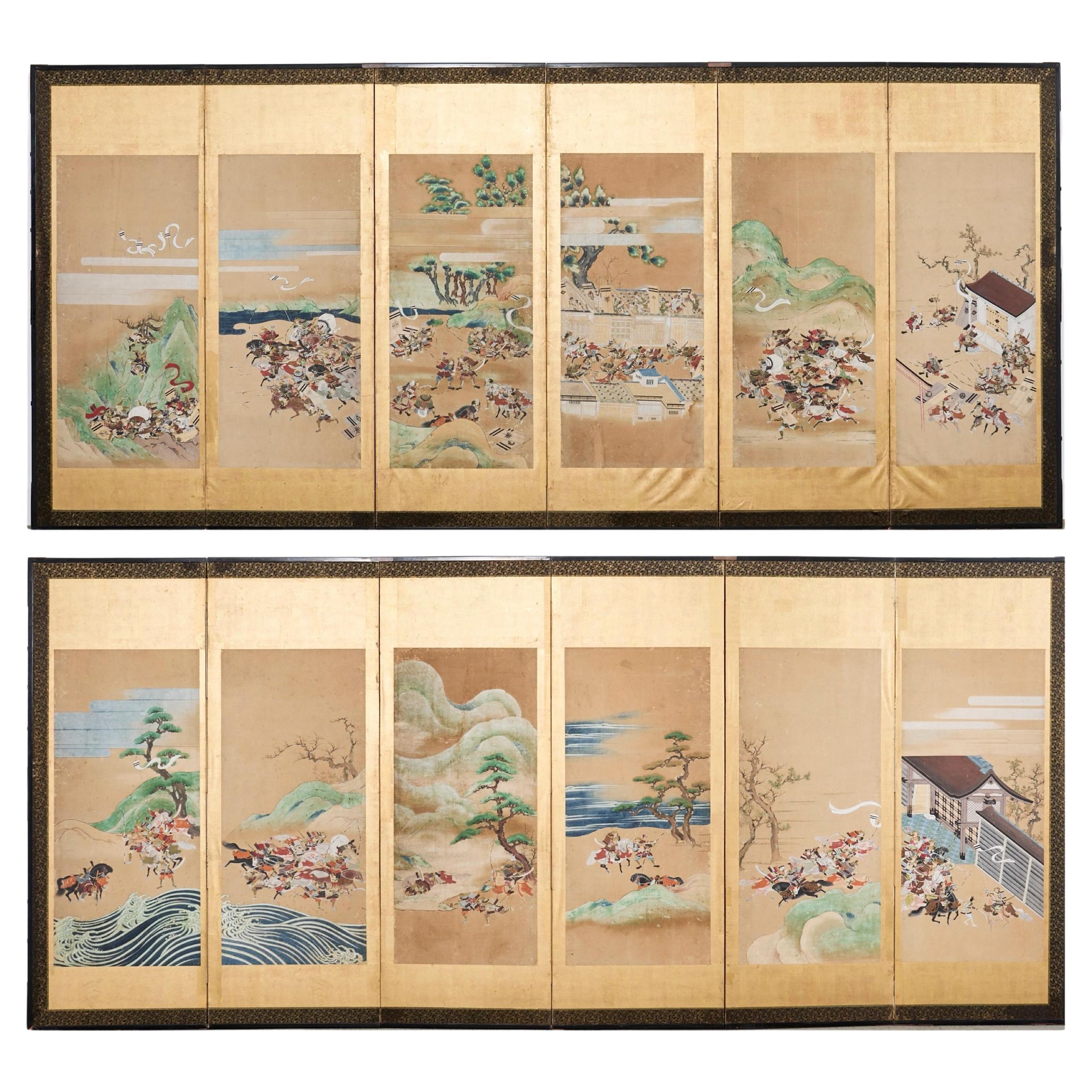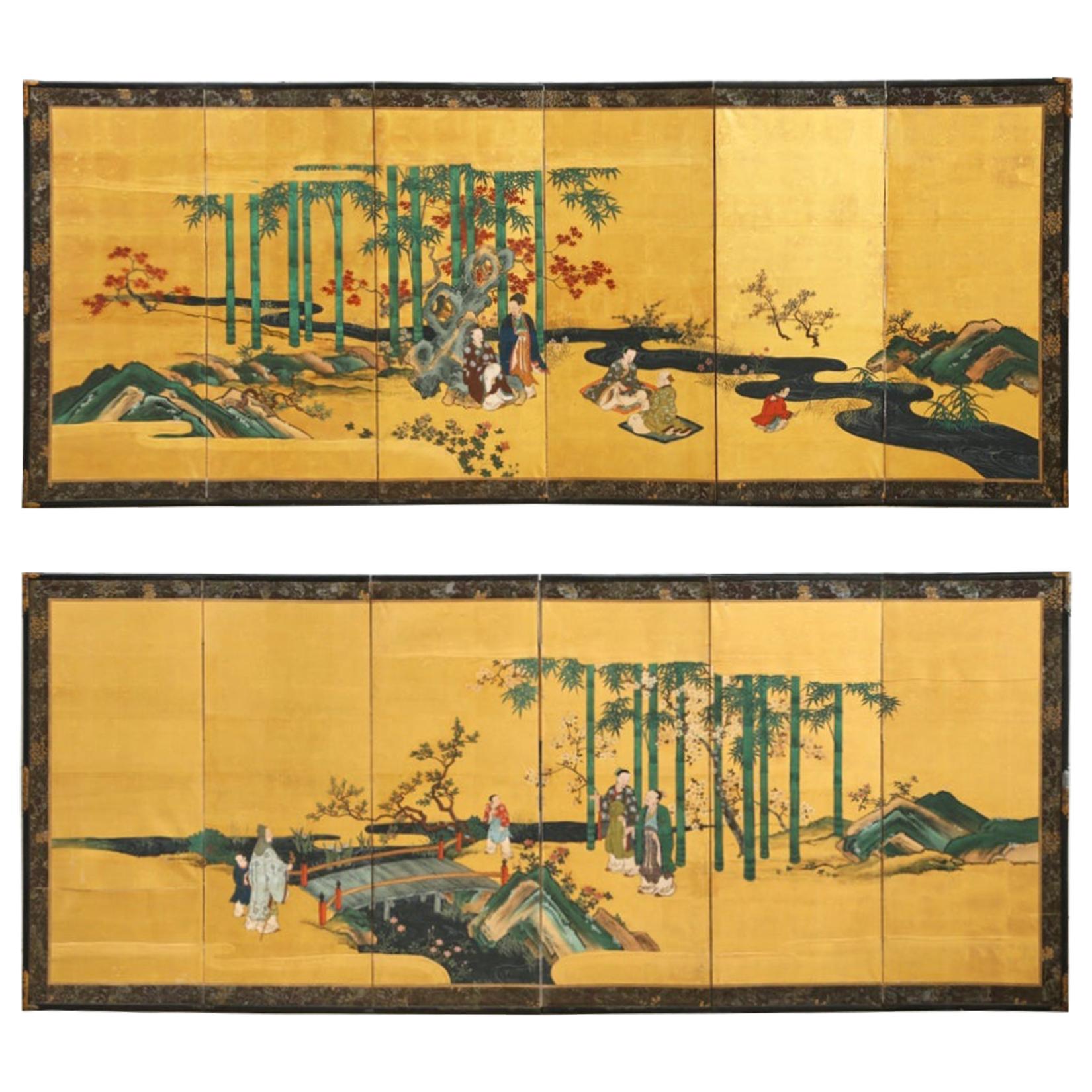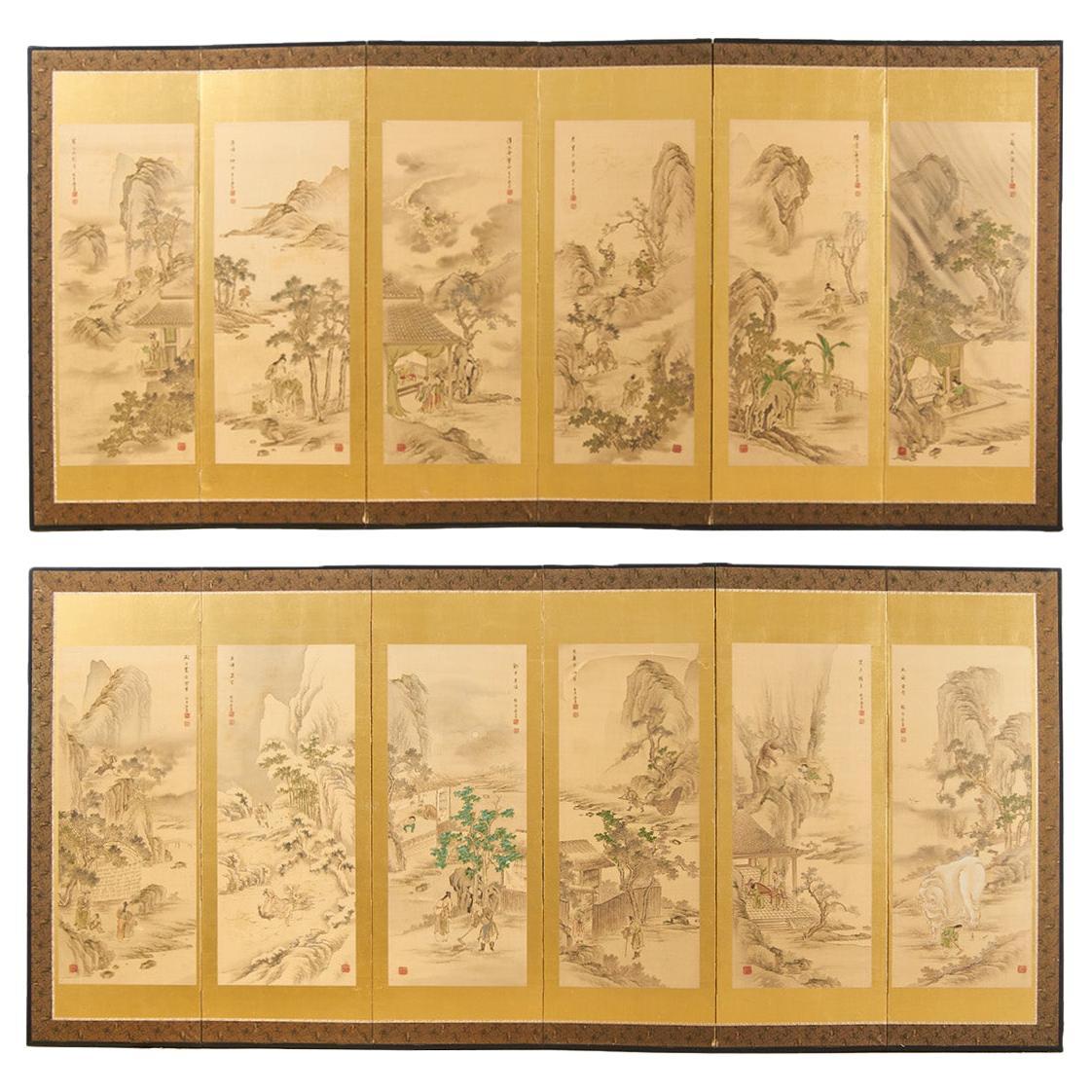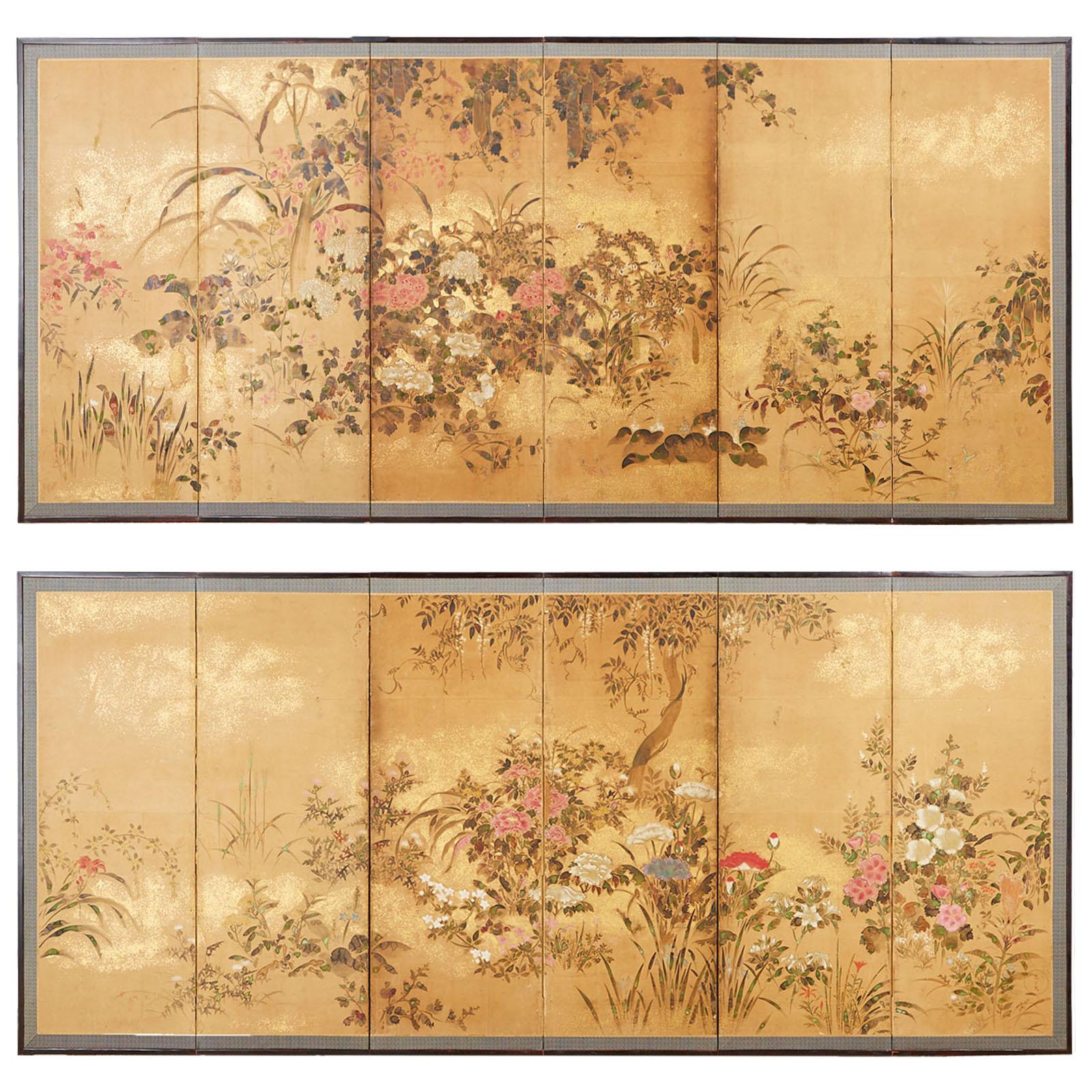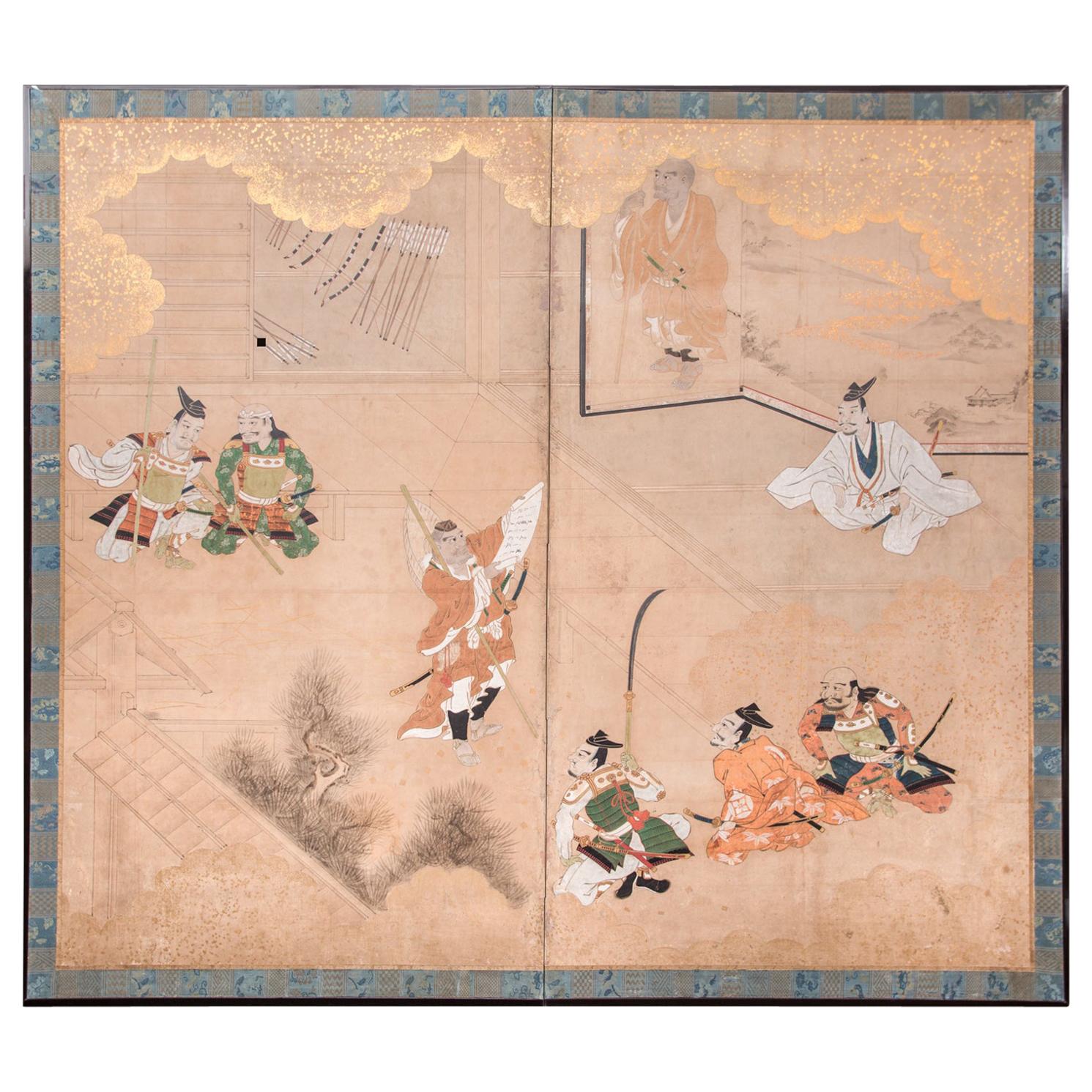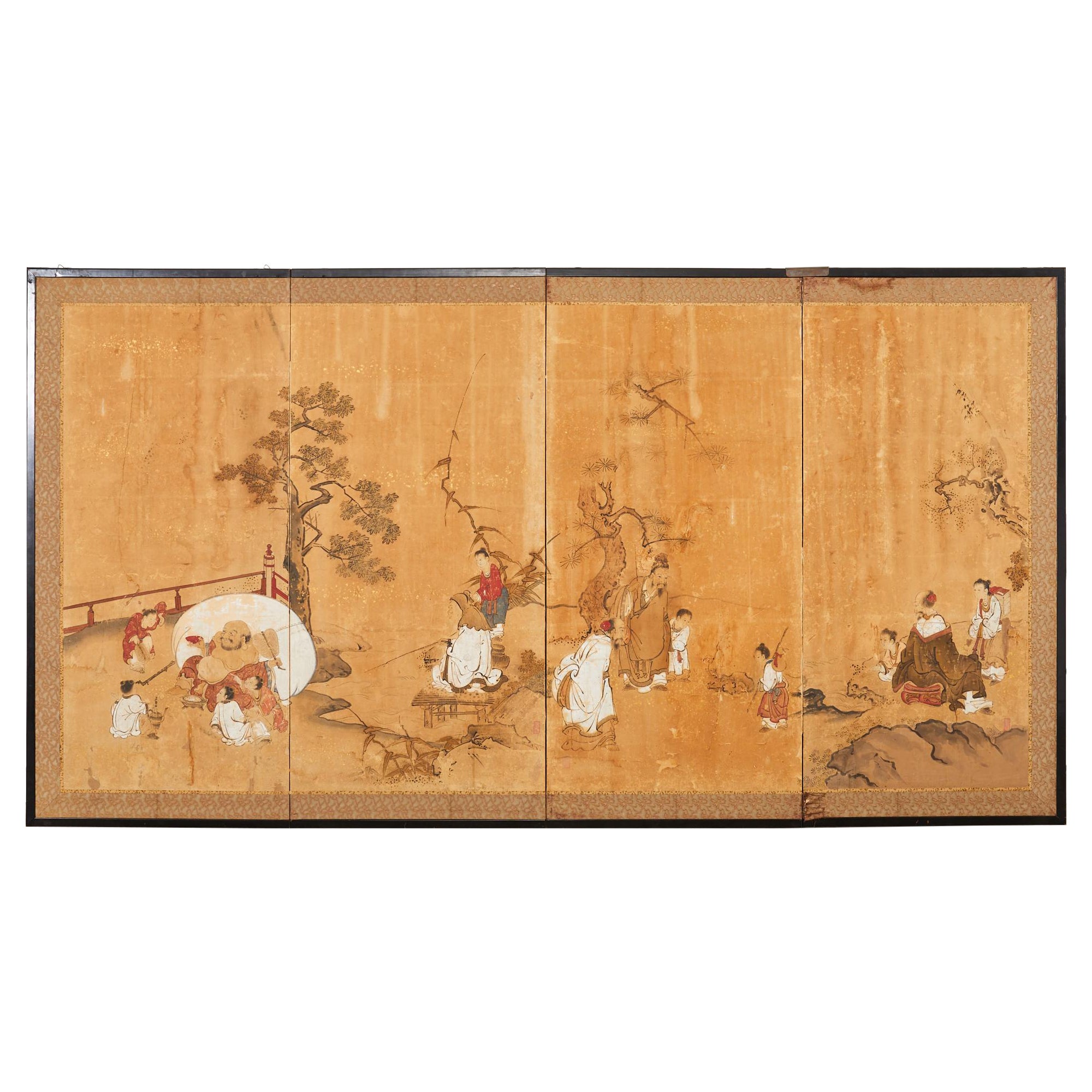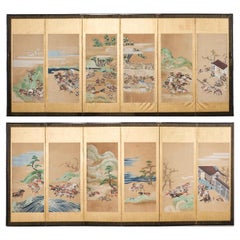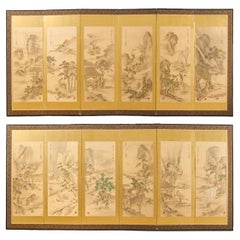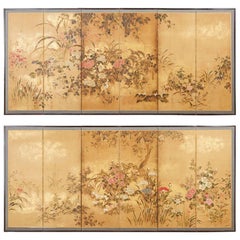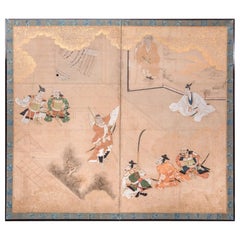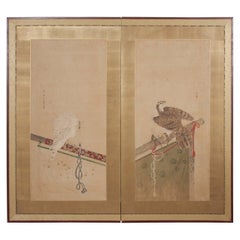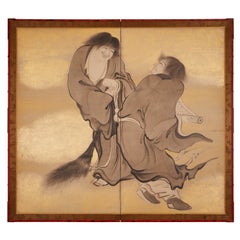Items Similar to Pair of 18th Century Japanese Edo Screens of Chinese Immortals
Video Loading
Want more images or videos?
Request additional images or videos from the seller
1 of 22
Pair of 18th Century Japanese Edo Screens of Chinese Immortals
$9,000per set
£6,871.46per set
€7,939.91per set
CA$12,634.30per set
A$14,082.24per set
CHF 7,388.47per set
MX$171,967.10per set
NOK 93,554.07per set
SEK 88,422.82per set
DKK 59,259.01per set
About the Item
Mesmerizing pair of late 18th/early 19th century Japanese Edo period byobu screens by Shibata Gito (Japanese 1780-1819). The paintings depict Chinese immortals in a dreamy landscape. Painted with ink and natural pigment colors on paper with gold flecks. Beautifully crafted in the Maruyama-Shijo school in the Edo period. Signed by artist with two seals Gito-Utsusu, Shi Gito and Ichu-ho. Impressive paintings having a grand appearance and scale. Aged patina with minor losses to commensurate age and use. From an estate in Beverly Hills, CA. Sold as a pair. Measurements are for each painting.
- Dimensions:Height: 66 in (167.64 cm)Width: 142 in (360.68 cm)Depth: 0.75 in (1.91 cm)
- Sold As:Set of 2
- Style:Edo (Of the Period)
- Materials and Techniques:
- Place of Origin:
- Period:
- Date of Manufacture:Late 18th/Early 19th Century
- Condition:Wear consistent with age and use. Beautifully crafted with an aged patina commensurate age and use as seen in photos. Age appropriate wear with minor fading, small losses, and light stains. The paintings show well in person with a grand appearance and scale.
- Seller Location:Rio Vista, CA
- Reference Number:1stDibs: LU1555245421642

About the Seller
5.0
Erin Lane Estate is based in the San Francisco Bay Area, and its team of furniture restorers, art curators, professional appraisers and Asia specialists sources prime vintage and antique furniture from the finest estates in Northern and Southern California. Erin Lane Estate specializes in Hollywood Regency, McGuire, Chinese and Japanese pieces.
Diamond Seller
Premium sellers with a 4.7+ rating and 24-hour response times
Established in 2000
1stDibs seller since 2015
3,013 sales on 1stDibs
Typical response time: 1 hour
- ShippingRetrieving quote...Shipping from: Rio Vista, CA
- Return Policy
Authenticity Guarantee
In the unlikely event there’s an issue with an item’s authenticity, contact us within 1 year for a full refund. DetailsMoney-Back Guarantee
If your item is not as described, is damaged in transit, or does not arrive, contact us within 7 days for a full refund. Details24-Hour Cancellation
You have a 24-hour grace period in which to reconsider your purchase, with no questions asked.Vetted Professional Sellers
Our world-class sellers must adhere to strict standards for service and quality, maintaining the integrity of our listings.Price-Match Guarantee
If you find that a seller listed the same item for a lower price elsewhere, we’ll match it.Trusted Global Delivery
Our best-in-class carrier network provides specialized shipping options worldwide, including custom delivery.More From This Seller
View AllPair of Japanese Edo/Tokugawa Screens Tale of Heiki
Located in Rio Vista, CA
Monumental pair of late 18th century Japanese Edo/Tokugawa period byobu screens depicting the battles between Taira and Minamoto. The screens have six panels each with individual sce...
Category
Antique 19th Century Japanese Edo Paintings and Screens
Materials
Brass, Gold Leaf
Pair of Japanese Edo Six Panel Screens the Seven Sages
Located in Rio Vista, CA
Fantastic pair of 19th century Japanese late Edo/early Meiji period six-panel screens titled The seven sages of the bamboo grove. The Kano school screens...
Category
Antique 19th Century Japanese Edo Paintings and Screens
Materials
Brass, Gold Leaf
Pair of Japanese Taisho Period Screens Paragons of Filial Piety
Located in Rio Vista, CA
Impressive pair of Japanese screens from the Taisho period meiji. Each six-panel screen depicts an image from the 24 paragons of filial piety ...
Category
20th Century Japanese Taisho Paintings and Screens
Materials
Brass, Gold Leaf
Pair of Japanese Edo Rimpa School Screens after Tawaraya Sōtatsu
Located in Rio Vista, CA
Impressive pair of 17th century Japanese Edo period Rinpa school screens made in the manner and style of Autumn Grasses by Tawaraya Sōtatsu (1570-1640). Beautifully decorated with wi...
Category
Antique 17th Century Japanese Edo Paintings and Screens
Materials
Gold Leaf
17th Century Japanese Edo Four Panel Screen Hotei with Chinese Sages
Located in Rio Vista, CA
Beautifully weathered late 17th/early 18th century Japanese edo period four panel byobu screen depicting hotei (fat monk) in a treed landscape with Chinese sages engaged in leisurely...
Category
Antique 17th Century Japanese Edo Paintings and Screens
Materials
Brass
Japanese Edo Two Panel Screen Deities by Yokoyama Kazan
Located in Rio Vista, CA
Whimsical Japanese late Edo period two-panel screen circa 1800 by Yokoyama Kazan (Japanese 1784-1837). The screen depicts four of the seven Gods or deities ...
Category
Antique 19th Century Japanese Edo Paintings and Screens
Materials
Brass, Gold Leaf
You May Also Like
Japanese Two Panel Screen: Genpei Warriors
Located in Hudson, NY
The Genpei War took place from 1180–1185, during which the Minamoto clan rebelled against the Taira clan for control of Japan. The two clans had a bitter rivalry for years, and the M...
Category
Antique Early 19th Century Japanese Edo Paintings and Screens
Materials
Gold Leaf
Japanese Edo Period Two-Panel Screen
Located in Stamford, CT
A Japanese Edo Period two panel folding screen with white and brown hawks of ink and color on paper.
Category
Antique Mid-19th Century Japanese Edo Paintings and Screens
Materials
Paper
17th Century Japanese Two-Panel Screen, Gibbons of Folklore
Located in Hudson, NY
Japanese two-panel screen: Gibbons of Folklore, Edo period (17th century) Kano School painting of gibbons in Japanese fables. The left panel represents a Japanese fable of a monkey a...
Category
Antique Late 17th Century Japanese Edo Paintings and Screens
Materials
Silk, Wood, Paper
Japanese Two Panel Screen: Kanzan and Jittoku
Located in Hudson, NY
Prominent figures in Japanese folklore. The Chinese poet-sage Kanzan is depicted with his scroll, and the Daoist sage Jittoku with his broom. Painting bears two seals of Nakanuma Sho...
Category
Antique Late 19th Century Japanese Paintings and Screens
Materials
Gold
Japanese Two Panel Screen, Chinese Literary Figures in Seascape
Located in Hudson, NY
Fine Kano School painting on silk with silk brocade border.
Category
Antique 19th Century Paintings and Screens
Materials
Brocade, Silk
Pair of 19th Century Japanese Screens
Located in Bagshot, GB
A pair of large 19th century Japanses Screens of Japanese scenery.
The screens also come with a wooden crate which would have been built for them at a later date in order to move ...
Category
Antique 19th Century Asian Other Decorative Art
Materials
Paper
$3,624 Sale Price / set
30% Off
More Ways To Browse
18th And 19th Century Paintings
Chinese Antique Signed Painting
Chinese Immortal
Pair Of Japanese Screens
Edo Screen Gold
Japanese Silk Art Landscape
Chinese Ink On Silk
Japanese Byobu
Byobu Screens
Japanese Screens Byobu
18th Century Japanese Screens
Byobu Japanese Screen Painting
18th Century Chinese Screen
Japanese Screen Gold Landscape
19th Century Chinese Painting On Silk
Japanese Immortals
18th Century Japanese Silk Painting
Gold Paper Byobu
